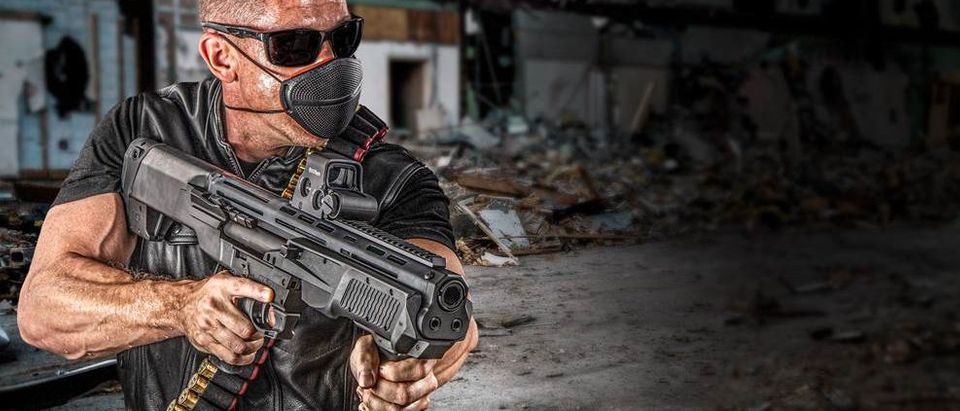By Daniel T. McElrath
When Smith & Wesson decided to build its first shotgun in 50 years, I’m guessing it took a hard look at the scattergun market, scouting for opportunity. Remington, the manufacturer of the vaunted 870 pump shotgun, was having trouble unrelated to that model, so that must’ve seemed auspicious. Even so, the really hot, burgeoning market niche seemed to be not mere pumps, but bullpup-configured pumps. They were innovative, they were exciting and they were offered by only a few small players in the U.S. gun business. It’s not unusual for a larger gun company to recognize the promise of a new design, then change it enough to overcome both problems and patents (if necessary), and introduce its own model backed by considerable marketing power. The Kel-Tec P-3AT leading to the Ruger LCP springs immediately to mind. (Kel-Tec didn’t patent the nested recoil springs crucial to the design, allegedly because Seecamp came up with them earlier.)
Not only can a large-scale manufacturer unveil a new firearm with great fanfare, the expected sales volume often allows it to introduce the gun at a consumer-friendly price point. In addition to being offered only by smaller manufacturers, some of which might even be labeled “boutique” gun- makers, some of the bullpups on or en route to the market were quite pricey.
New Tricks For An Old Dog
Before going into the nuts and bolts of Smith & Wesson’s offering, it might be good to explore exactly what is a bullpup long gun. A buttstock, whether on a rifle or shotgun, serves two very simple, basic functions: It provides a bridge between the receiver and shoulder against which to brace the gun, and offers a comb upon which the shooter rests his or her face. That accomplished, much of the buttstock was, for a time, wasted real estate (if you didn’t consider it a last-ditch impact weapon). Soon, though, some were drilled out to create onboard storage space for maintenance items and small spare parts. Successful designs ranging from the Spencer carbine of the Civil War era to the Remington Nylon 66 of 1959 through the 1980s, routed the magazine through the buttstock. Competitive shooters sometimes inserted a wedge of lead in the stock to add weight to the gun and dampen felt recoil. Still, other builders recognized that with the two aforementioned functions satisfied, there was no reason for the rest of the buttstock and so skeletonized them. The bullpup design came about 150 or so years ago when someone realized you could move the very action itself back into the buttstock (or, at least the wrist), thereby shortening the gun without having to shorten the barrel.
And, that is the major advantage of the design: compactness. The disadvantage of the design is that detonation of the cartridge/shotshell takes place right next to the shooter’s face. Though it really isn’t an issue with modern steel and safety-forward design, it can still be a little unnerving. Some would add aesthetics (or the lack thereof) as a disadvantage, too, but the graceful lines of the commercially successful Steyr AUG largely put that to rest—at least for rifles.
Mossberg made the most notable early, large-scale foray into bullpup shotguns in the 1980s, with bullpup variants of its Models 500 and 590. Some of today’s models, though, offer a second selling point: high firepower.
In addition to being bullpup designs, a few of the new shotguns on the market feature two magazine tubes, thereby doubling the firepower of single-magazine shotguns, whether of bullpup or conventional design. Competition shotguns today often have ungainly, extended magazine tubes and even they can’t match the capacity of a shotgun like the Smith & Wesson M&P 12. Springfield, MA’s (well, until the company moves to Tennessee in 2023) new scattergun has a magazine capacity of 14, 23⁄4-inch shotshells, or 12, 3-inch magnum shotshells, or 20, 13⁄4-inch mini-shotshells. In all instances, you can also chamber an additional round to add even more capacity while keeping the tubes full.
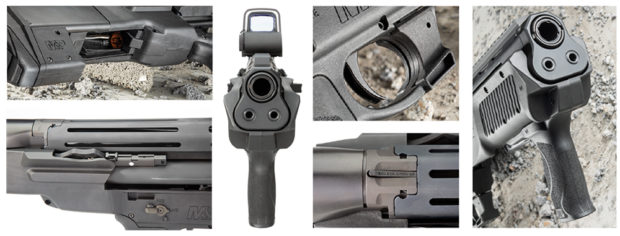
–
Feature Rich
A bullpup configuration and enhanced capacity are but two of the attributes the M&P 12 brings to the table. Coming late to the game provided Smith & Wesson a view of the field. In addition to its brand appeal and marketing resources, it possessed the R&D capital to incorporate feature after feature to overwhelm the competition with a matchless, comprehensive host of useful design elements.
The M&P 12 comes with a foam-lined, plastic hard case. It’s not great (the latches tend to pop off), but way better than a cardboard box. Besides, one doesn’t perform an oral inspection of the freely given equine.
The initial visual impression made by the shotgun is admittedly mixed. It looks “plasticky.” The fore-end, vertical fore-grip, pistol grip and the lower receiver are polymer, and that does dominate one’s first impression. Also, the inherent play in the fore-end of a pump makes the gun seem loose. Adding to the aesthetic challenges presented by the M&P 12 is the unavoidable fact that, as a bullpup shotgun, it’s just odd looking. Bullpup shotguns, despite designers’ best efforts, simply lack a certain visual grace.
Hefting the gun doesn’t help matters. That much plastic saves weight, right? Guess again. The steel receiver and barrel, as well as the metallic barrel shroud, loading port and comb make for a heavy gun—compact, yes, but heavy.
First impressions around the office were consistent: People either scowled or winced at the appearance, yet nodded approvingly as the various features were identified. As they are many, let’s begin at the muzzle and go through them.
The M&P 12 has a threaded muzzle and is compatible with RemChoke tubes. It comes with both Cylinder Bore and Improved Cylinder tubes. It’s good to have options.
The fore-end itself has a scalloped, wave-like pattern that, in addition to offering excellent purchase as you rack the slide, is likely the prettiest part of the gun. Attached to it is the removable, vertical fore-grip.
There’s a barrel shroud with M-Lok slots for affixing accessories. Atop that is a Picatinny rail. The shotgun comes without sights but, given the rail, readily accepts irons or a red dot of the end-user’s choosing.
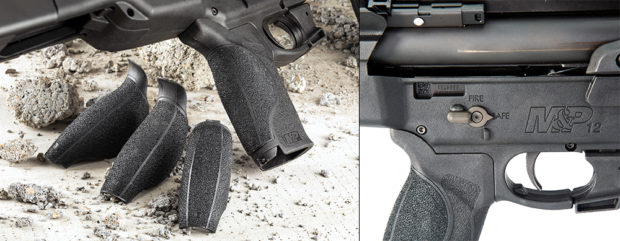
–
A crossbolt magazine selector button lets you choose which magazine to feed from. It’s large, and functions positively (for the most part).
Incorporated into the front of the trigger guard is the slide-release latch. Press down on the ledge of the latch with your trigger finger or the side or forefinger of your support hand and you are free to cycle the action without pulling the trigger.
The M&P pistol grip, in addition to being ergonomic and well-textured, has three additional palm-swell inserts so you can customize the fit to your hand.
Just as the pistol grip offers familiarity in this radically different-looking gun, the ambidextrous safety selector, similar to that of the AR-15, lends instant comfort and competence to anyone used to operating “America’s rifle.”
Above and behind the pistol grip, on either side of the action, are two loading-assist levers, one for each magazine. Partially compress one, and its respective magazine becomes easier to load. Fully compress it, though, and the magazine promptly disgorges its contents.
Atop the rear of the receiver a protrusion emerges from a slot when a round is chambered, serving as both a visual and tactile loaded-chamber indicator. The buttstock also includes a base for a QD sling.
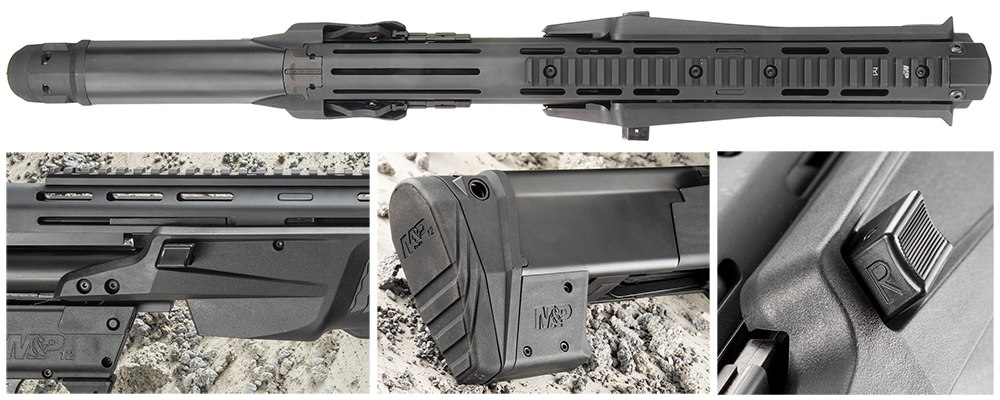
–
Shooting And Handling Impressions
I mounted an EOTech holographic sight on the M&P 12. It made a nice combination and, by sheer luck, was centered just as I installed it, no adjustments needed.
I have heard several people complain about the difficulty loading the gun. They had to be kidding. I figured it out in about 40 seconds. Don’t hold it upside down; turn it over, then rotate it so it’s almost on its side. The shotshells fit in a little tray in the sidewalls of the loading port, not the top. Simply lay each shell on this tray and shove it forward with your thumb. I didn’t even need the loading-assist levers.
Shouldering the gun and cycling the action using the vertical foregrip makes you feel like the world’s most dangerous trombone player.
The feel of the gun in your hands, however, is “meh.” Short-but-heavy and brick-like, its weight is centered between your hands. You can swing it adequately, but there is a good deal of inertia to overcome for a gun this short.
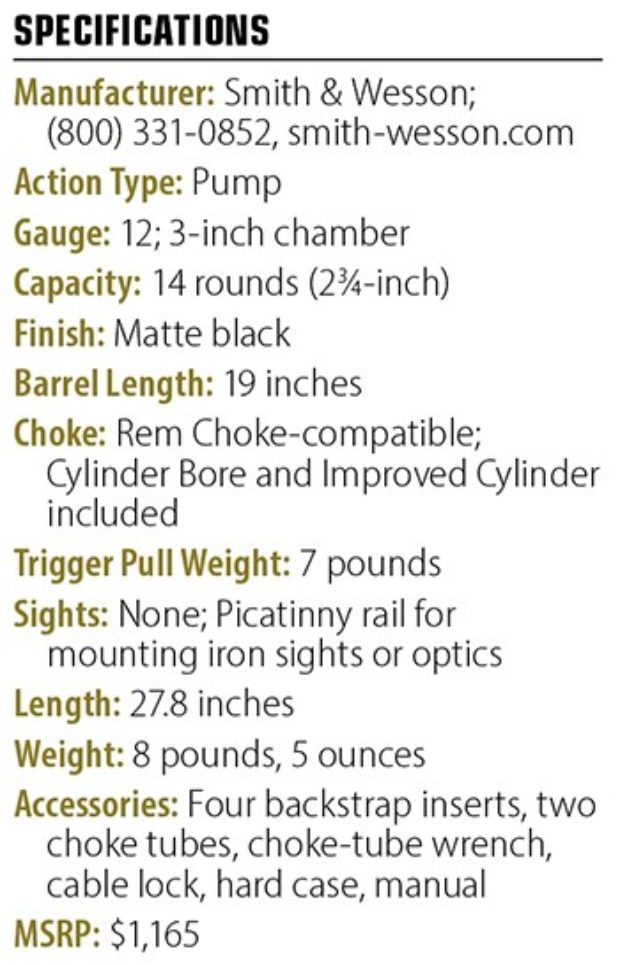
I shot it with Federal Premium Force X2 Personal Defense 2 3⁄4-inch 00 buck, Remington 2 3⁄4-inch 00 buck, Winchester Double X 3-inch 00 buck and Aguila 12 Minishell 1 3⁄4-inch buckshot. Despite the weight, felt recoil was not as diminished as I’d have hoped. The butt of the gun is quite hard and the comb, surrounding and reinforcing the loading port as it does, is made of metal and not particularly comfortable. The vertical foregrip, though, can be used to minimize muzzle rise. The 2 3⁄4-inch loads were easily tolerable while the 3-inch shells weren’t (for long), but the Minishells were downright fun.
A lot of people have speculated that the dual magazines could allow the user to keep two different loads in the gun and select the appropriate one for the circumstances. For example, you could put less-lethal projectiles (bean bags?) on the left and standard buckshot on the right. Or you could put buckshot on one side for two-legged threats and 3-inch slugs on the other if you’re in big bear country. One advantage I haven’t heard pointed out is the usefulness of two magazines for couples or family members of disparate strength or skill levels. A petite woman (or smaller or older man) could select minishells for defense, yet with the press of a button, a larger, stronger individual could dial up the 2 3⁄4-inch 00 buck.
I’m one for aggressively handling firearms in general and pump shotguns in particular. When instructing new shooters, I stress they not fear the gun nor let in control them. In fact, I urge them to dominate the gun, holding it tightly and really leaning into it. This is particularly true with pump shotguns, where the potential to short-shuck exists. I work the slide like it owes me money and that approach worked well with the M&P 12.
There were no failures to feed or fire with the full-size shells and only one hang-up with the last round out of a magazine with the minishells. It was easily cleared. When one tube ran dry, you had only to look for the prominent magazine selector and push it to the other side, then rack the gun in order to resume firing. I was initially afraid the manual-of-arms would be confusing, but the secondary controls of the M&P are well-sized and readily apparent. You under-stand how to do everything you need to with just a few minutes of practice. One caveat, though: When you lay the M&P 12 on its side and that side happens to be the one the magazine-selector button is pressed for, the weight of the gun will collapse the button, pushing it up and to the other side. The gun will thus be set to operate from the other magazine. Oops.
Findings?
There is a considerable number of innovative features here, and most of them work just fine. Though it represents a radical departure for both manufacturer and customer base, the Smith & Wesson marque should go a long way to easing buyers’ doubts. Whether you’re a fan of bullpup shotguns or not, the configuration has an indisputable virtue in its compactness and the M&P 12 adds to that its eye-opening firepower. As long as a gun functions the way it’s supposed to and is safe to operate, it’s difficult to speak ill of it, and the M&P 12 is a strong case in point. Fifteen rounds of 12-gauge shotshells available to be quickly delivered from a compact and reliable platform? How can that be a bad thing?

Editor’s Note
As we were going to print with this issue, Smith & Wesson issued a recall on all M&P 12 shotguns manufactured prior to Oct. 15, 2021. An extremely rare, but potentially dangerous barrel failure prompted the decision. All M&P 12s manufactured after that date will sport newly designed barrels and won’t have this unlikely, but real safety concern. We did not run into any safety issues in our testing, and because of the lateness of the recall relative to our schedule, we elected to run the review with this note.


